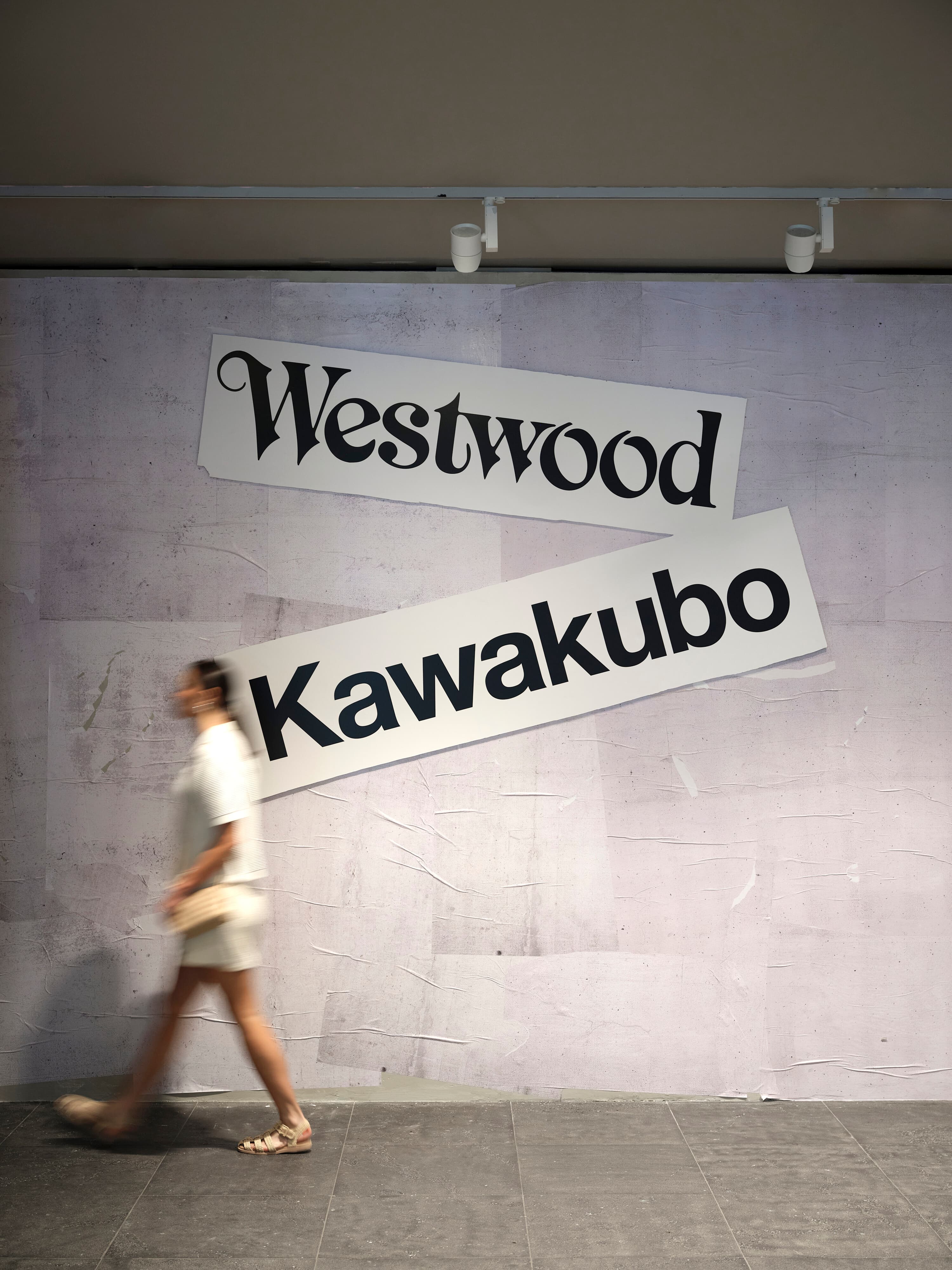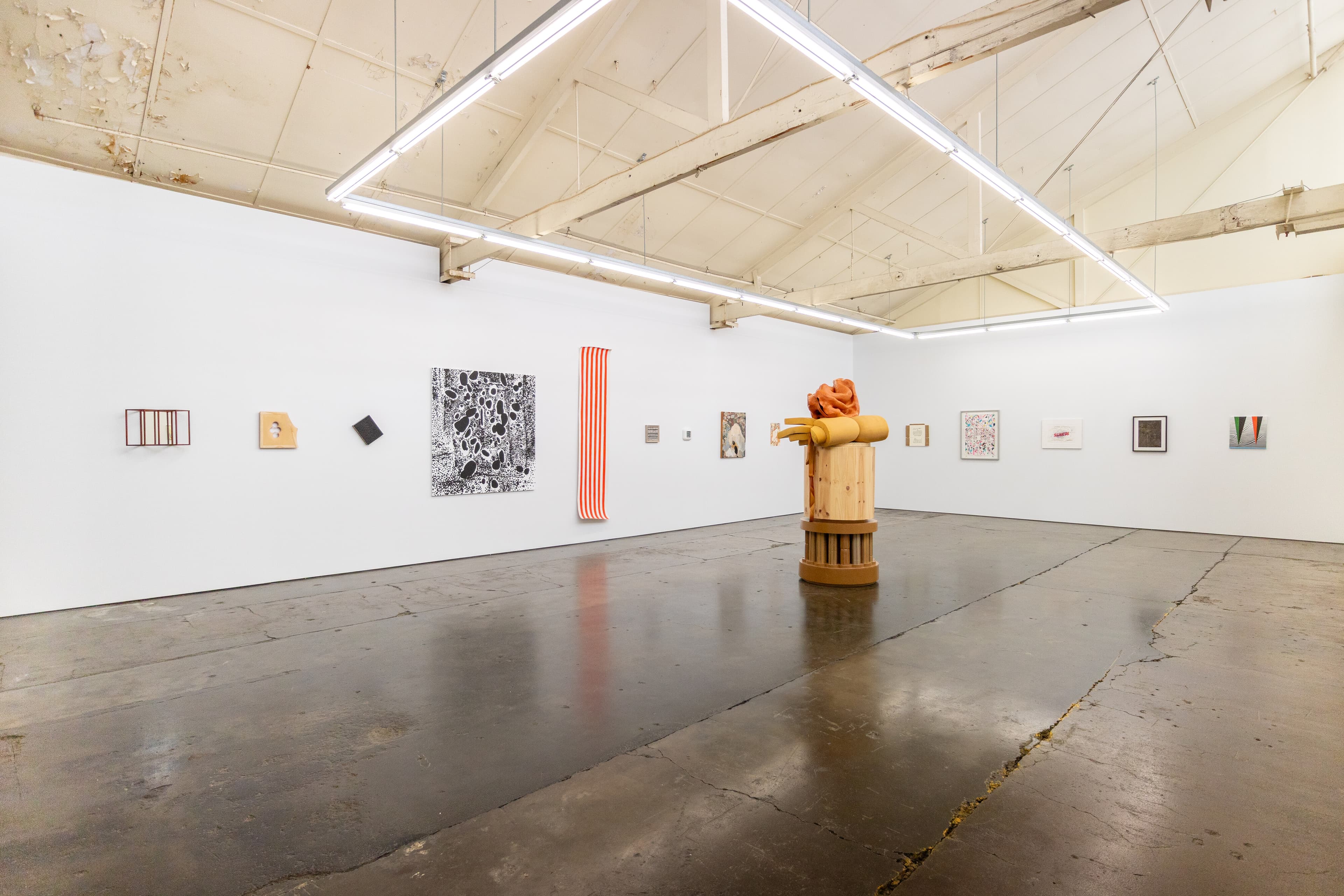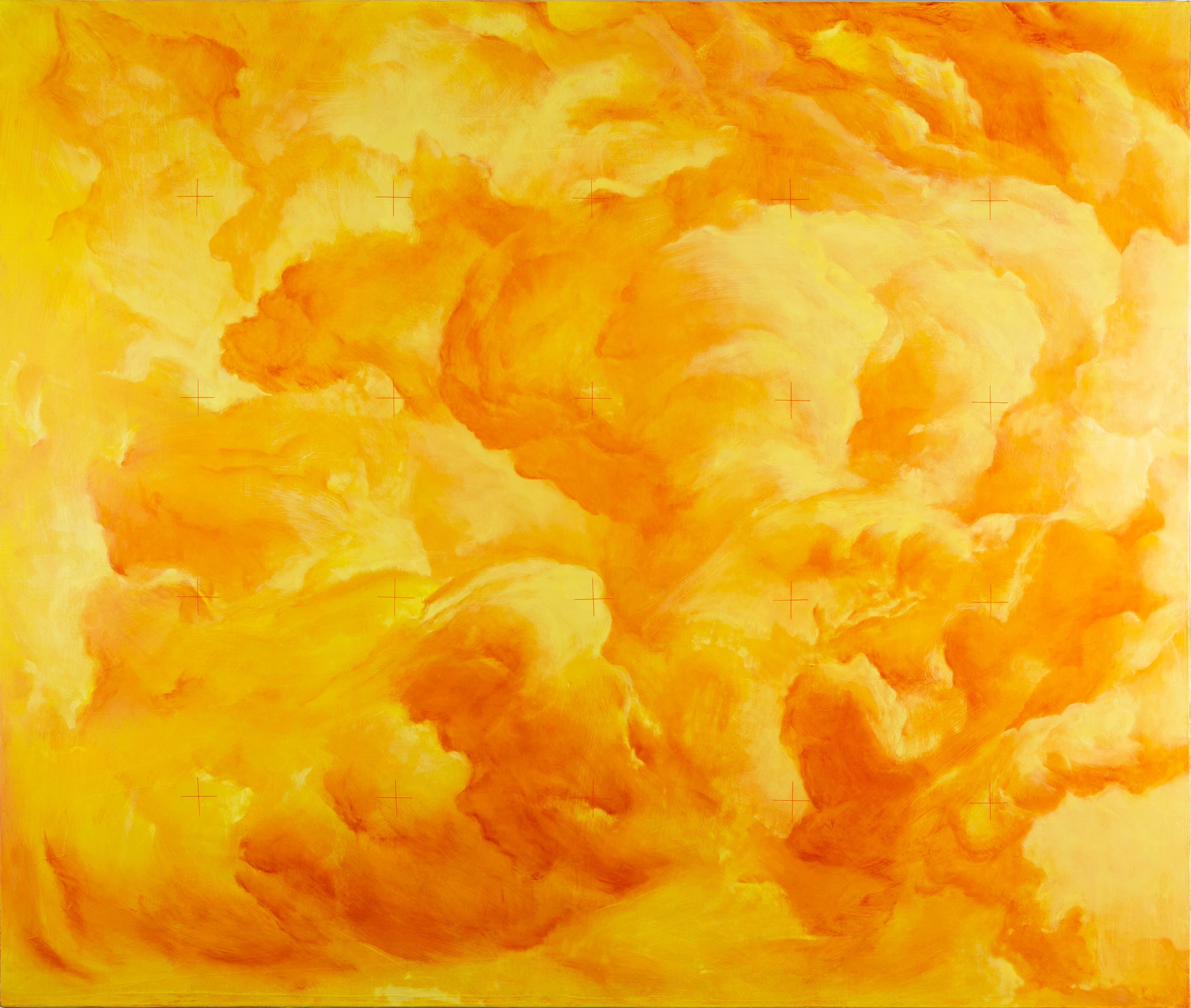Installation view of Rosslynd Piggott and Rudi Williams, Mirror, mirror, Sutton Gallery, 2024. Photograph: Andrew Curtis. Image courtesy the artists and Sutton Gallery.
Mirror, mirror
Cameron Hurst
In 1993, Rosslynd Piggott knelt before the belly of her friend Annette with a glass test tube and captured some air. They were in Milan. Annette was pregnant. Piggott sealed off the container and wrote a note recording the location and date, in keeping with the practice she had developed for the larger collection of vessels that made up her “air diary.” (The echo of Duchamp’s Air de Paris is not incidental.) Just over thirty years later, that small glass time capsule from Italy still exists and the then-unborn baby, Rudi Williams, is now an adult woman. She is also an artist. Williams grew up witnessing Piggott’s practice, and moments from the pair’s decades-long artistic encounter are staged in Mirror, mirror.
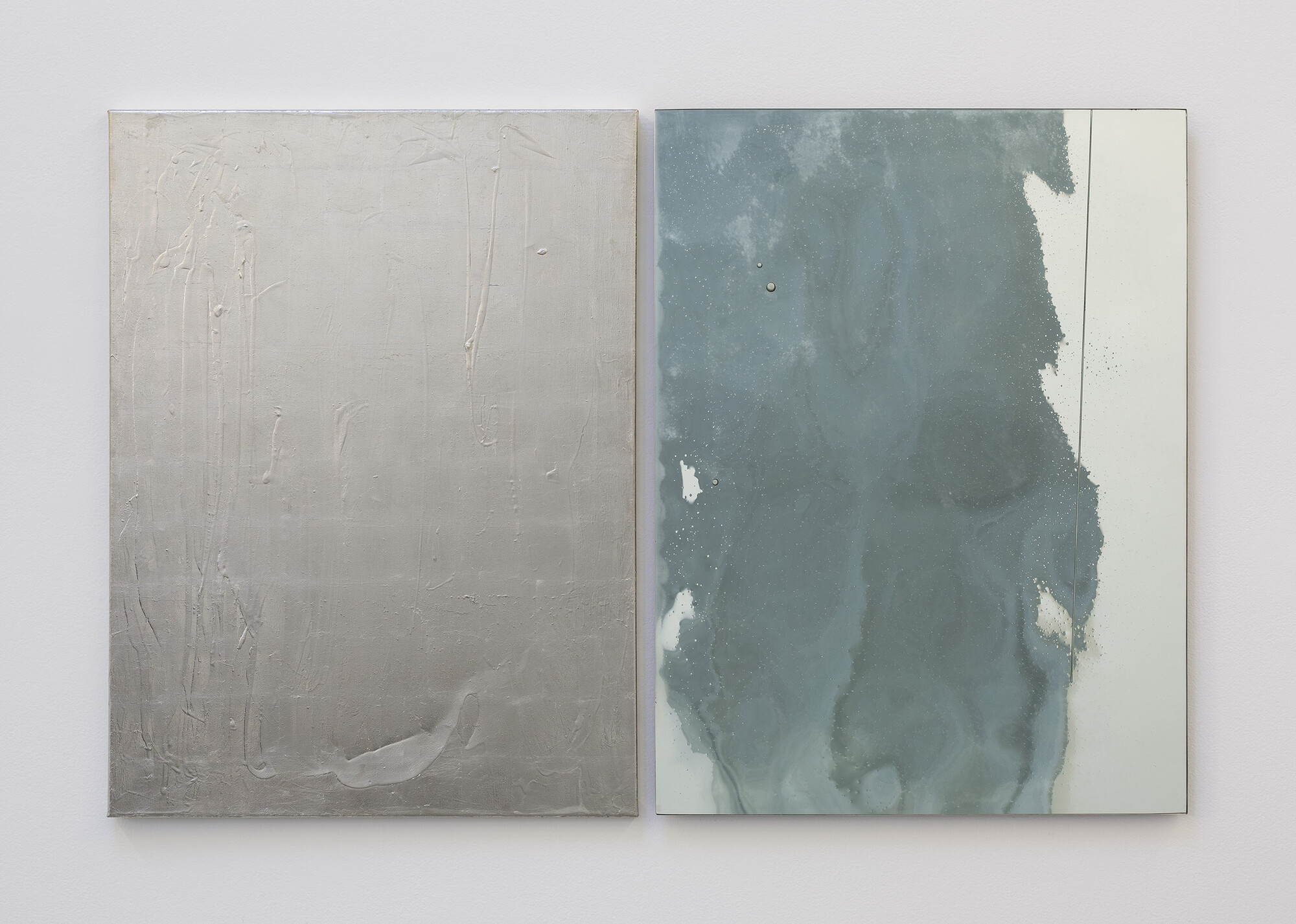
Rosslynd Piggott, Mirror, mirror I, 2007-2008, oil and palladium leaf on linen; hand slumped, sandblasted and mirrored glass, two panels, 100 x 75 x 2cm (each). Photograph: Christian Capurro. Image courtesy the artist and Sutton Gallery.
The exhibition is in the first room of Sutton Gallery (the adjacent, larger space is occupied by a solo show by Nick Selenitsch). It comprises one work by Piggott and six photographs by Williams. The former, the source of the exhibition title, is Mirror, mirror I (2007–08): two silvery panels measuring 100 by 75 centimetres. The left panel is a canvas gilded with layers of palladium—a “noble metal” that does not oxidise. Slicked with a thick, slow-drying oil primer then covered with multiple layers of fine sheets of gilt, the canvas has a luminescent sheen and features gloppy, liquid passages that give the object a molten appearance. The other panel is in a different metallic medium: it is a mirrored glass rectangle, cut meticulously to the same size as the palladium painting. In recent years, Piggott has worked with highly skilled artisans, in Murano and elsewhere, to create glass objects inscribed with intricate patterns. This is a simpler affair. The pane is speckled by three bubbles and a vertical line bisects the right-hand side at a slight inward angle, stopping before the edge. These two objects are displayed on the left wall of the gallery space. The central and right walls display the photographs by Williams.
There are six of these photographs, all the same size—ever-so-slightly smaller than Piggott’s paintings. Each is an image of spaces Piggott’s art has been exhibited in over many years, taken through the reflection of a mirror panel. They are presented in chronological order. Two are from Murmur, a 2013 show at the Johnston Collection. One is from Cumulus, Piggott’s 2017 PhD research exhibition, held in her Fitzroy studio. Two are from I sense you but I cannot see you, a major survey show held at the NGV in 2019. The final image is new, created in Piggott’s studio specifically for this exhibition. The photographs are an evocative homage to Williams’s relation to Piggott, who plays twinned roles of intimate family friend and influential older artist (a similar, albeit grungier, nod to the importance of local social networks and artistic inheritances appeared in Asbestos’s closing show, Establishment, last weekend).

Installation view of Rosslynd Piggott and Rudi Williams, Mirror, mirror, Sutton Gallery, 2024. Photograph: Andrew Curtis. Image courtesy the artists and Sutton Gallery.
The genesis of Mirror, mirror was organic. Williams describes the way she works as a process of “intuitive accumulation”—constantly making images that she adds to her archive to return to at an unspecified later point. Over a decade ago, using her 4×5 camera, she captured some images through a mirror work installed at Piggott’s Johnston Collection show. “I remember processing them and thinking they were really interesting, but knowing that they weren’t for that moment in time,” Williams says. In the following years, she photographed the other shows in a similar manner; then one day, realised a collection of sorts had developed.
Williams’s way of describing making art invokes a quasi-spiritual abnegation of control—a guiding hand, a higher power. The right time will reveal itself at the right time. Nothing good can be forced or overdetermined. Piggott shares the tendency. It could all sound a bit astrological. But this intuitive approach is underpinned by a meticulous attention to creating technically complex objects—both artists are invested in maintaining time-consuming, historic artistic techniques, whether working alone in a quiet darkroom or in collaboration with glassblowers.
I trust their arcane logic. Williams’s photographs are beautiful—fleeting moments that coalesce to form a coherent group. When I first walked into the gallery and saw them, it was like encountering a series of images captured from shadowy, irretrievable dreams about Piggott’s art. This was especially true given my memories of visiting the older artist’s exhibitions in Melbourne. “Rudi’s art is a portal,” Piggott told me.
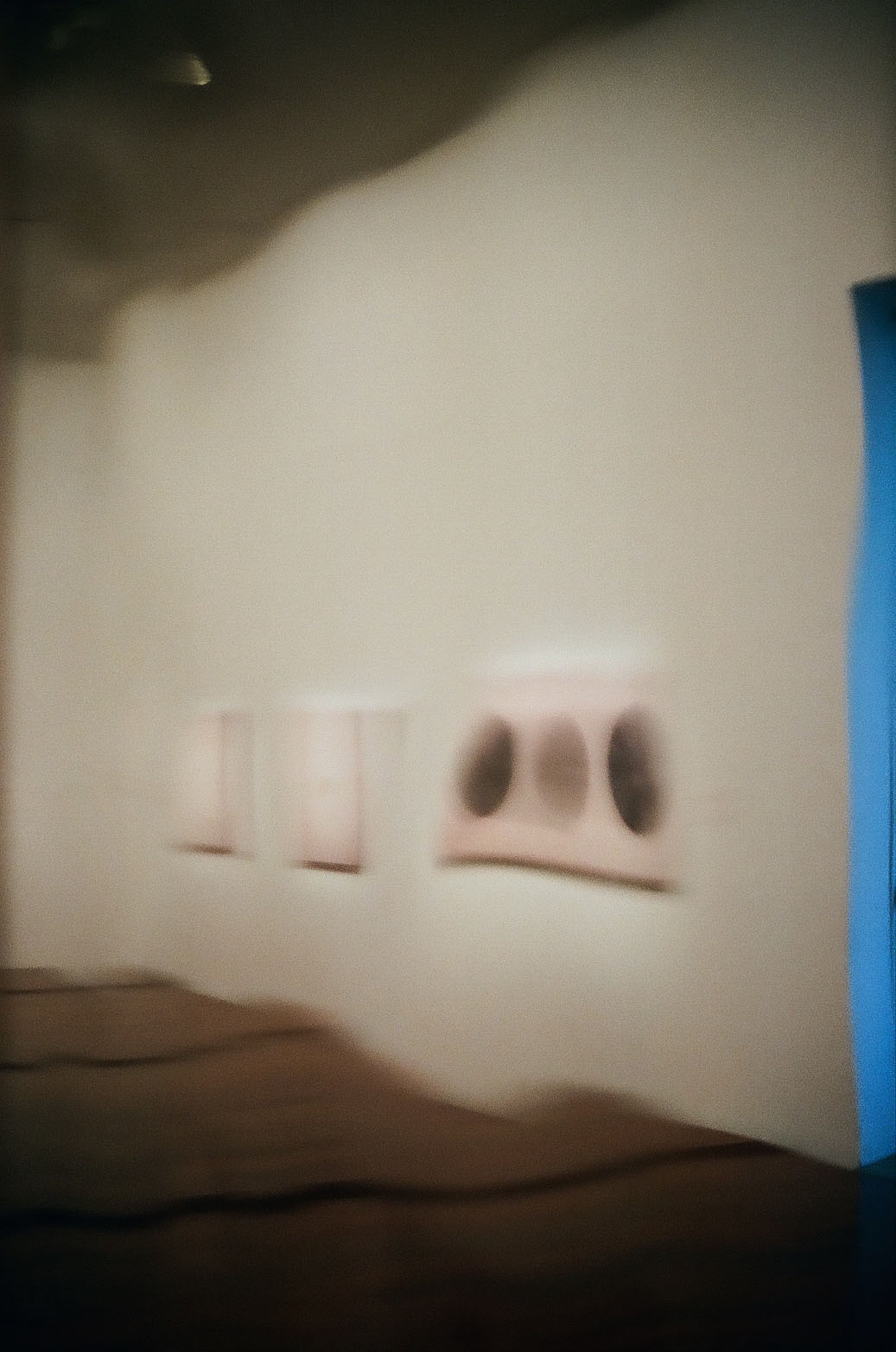
Rudi Williams, 2019: ‘Mirror, mirror x 3 (2008)’, Rosslynd Piggott ‘I sense you but I cannot see you’ exhibition, The National Gallery of Victoria, Melbourne, 2024, hand-printed Chromogenic print and ink on Dibond, 98.5 x 65.5cm. Image courtesy the artist and Sutton Gallery.
Two hazy pictures with dark wooden floorboards, taken in the Ian Potter, triggered associations to I sense you but I cannot see you: a painting of a bowl filled with eggs, a boy from the past, ephemeral cherry blossom palettes. In the distorted photograph of Piggott’s PhD exhibition, I recognised a large-scale, palest-blue and pink-hued painting like ones displayed in a show I’d seen a few years later. It had been reviewed in Memo by the ever-memorable Philip Brophy, who discussed Piggott’s work in relation to art-historical discourses about “decorative art.” He’d argued that to take a pejorative, reparative, or really any overly theoretical interpretative approach to the decorative was to head down the wrong path. “Committed decorative art … cares naught for gendered/feminised/maternalised stances,” he wrote. “In place, it accepts the labour of its fruits and is content to withdraw into optical hermeneutics and sensorial stylistics.” Slow down. Touch the grass, smell the roses, embrace tradition. Ornament is not crime!
The most obviously “decorative” and, to my eye, most lovely inclusions in the Sutton show are Williams’s images of Piggott’s installation in the Johnston Collection. This Victorian townhouse museum in East Melbourne holds a collection of Georgian English, Regency, and Louis XV objects gifted to the state in 1968. Called “Fairhall,” it was owned by the antiques dealer William Johnston. Johnston had not inhabited the beautiful rooms of Fairhall alone. He had shared the place over the years with other men, Angus Winneke and Ahmed Moussa Abo el Maaty, who were companions, chosen family. Piggott has long been interested in houses and house museums—her PhD examined the subject. Part of this research project involved the Johnston Collection show, Murmur, wherein she curated the display of objects from the permanent collection alongside showing new and existing work of her own.

Rudi Williams, 2013, Yellow Room: ‘Mirror, mirror II (2008-2009)’, Rosslynd Piggott ‘Murmur’ exhibition, The Johnston Collection, East Melbourne, 2024, hand-printed Chromogenic print and ink on Dibond, 98.5 x 77cm. Image courtesy the artist and Sutton Gallery.
I see this exhibition only through Williams’s transmogrifying documentation. Warm tungsten light illuminates one room, warped in the reflection of Piggott’s mirror work and filled with the luxuriously varied textures of Johnston’s collection. There is an angled chair with an embroidered chartreuse velvet cushion, wicker weft, and glossily oiled wooden arms; a pinstriped yellow wallpaper, lines wavering; and an eighteenth-century society portrait of a young woman in a satiny blue-and-white gown fingering a small bunch of roses, her face obscured by a stretch of thin white fabric draped over the top of the picture frame like a veil. In these photographs, the accoutrements of an aristocratic past are transported to a psychologically mysterious shadow realm.
The domestic display brought to mind Louise Lawler’s classic photograph Pollock and Tureen, Arranged by Mr. and Mrs. Burton Tremaine, Connecticut (1984). But Lawler’s juxtaposition is acid: the cropped shot of serious AbEx hung above dowdy crockery makes a wry comment on suffocating bourgeois interior design principles and, by proxy, the less-than-Greenbergian endpoints of the modern art market. Williams’s compositions are oriented towards more harmonious aesthetic experiences.
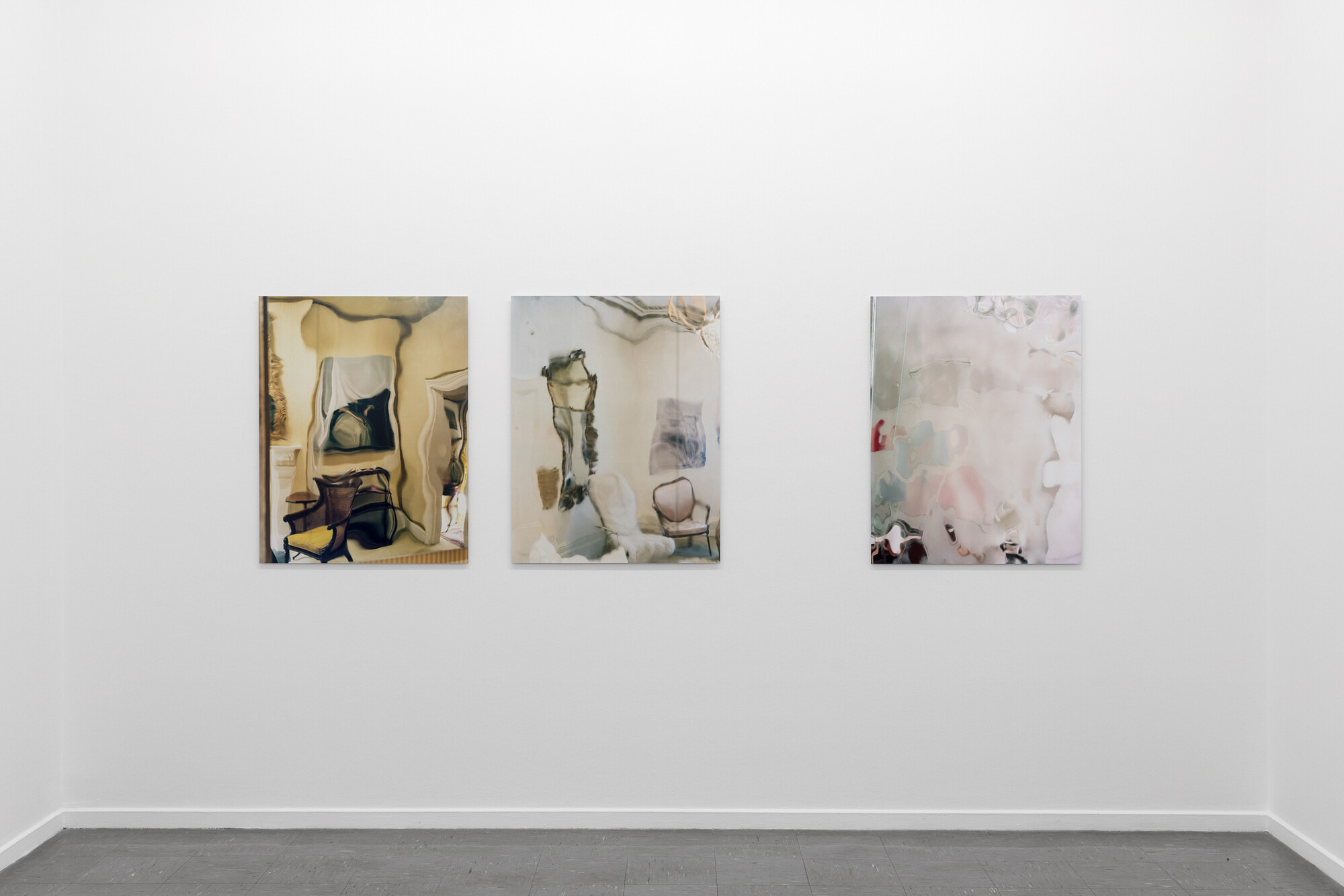
Installation view of Rosslynd Piggott and Rudi Williams, Mirror, mirror, Sutton Gallery, 2024. Photograph: Andrew Curtis. Image courtesy the artists and Sutton Gallery.
The feeling of encountering very different spaces and different kinds of objects unified by an ineffable sense of style runs throughout Mirror, mirror. If one had to stage the arguments of an ungenerous critic, this ambient loveliness could be seen as an artistic approach that is style-over-substance indulgence, a privileged stance devoid of political radicalism. Sure. But come on… there are far, far easier paths in this life to choose than “artist.” To become an incorrigible aesthete is often a way of dealing with the difficulties presented by an uncaring—or, indeed, actively brutalising—world.
Considering Mirror, mirror, with its fragile evidence of tastes refined over lifetimes, I was reminded of the filmmaker Terence Davies. Davies grew up Catholic in the north of England in the 1950s. He was gay, and experienced profound social alienation. His films—about his childhood, Emily Dickinson, postwar British marriage—are like nothing else. Alongside a recurring fixation on the family’s capacity to generate both anguish and a sense of deep belonging, Davies’ oeuvre contains an obsession with capturing the nature of time and its uneven passage. This is arguably the leitmotif of the Sutton show. What could be a bigger subject? I’m loath to ruminate on “time” at length or with sincerity, because I feel constitutionally incapable of the seriousness needed to do it justice. That’s why artists exist: sensitive souls capable of fixing not just on what happened, when, and what it looked like, but how it felt. How it feels now.
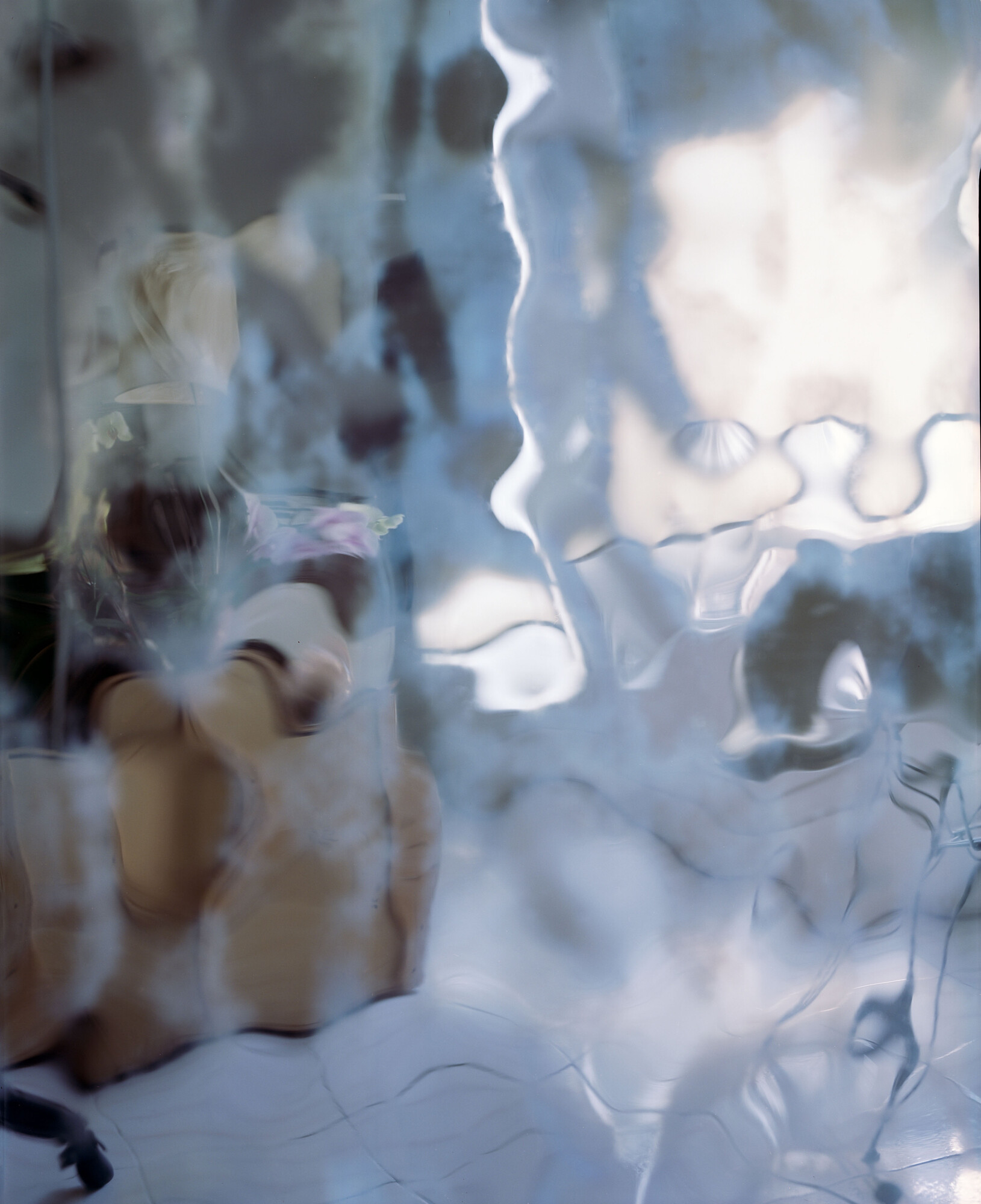
Rudi Williams, 2024, Blooming orchid: ‘Mirror, mirror III (2008-2009)’, Rosslynd Piggott, The artist’s studio and apartment, Fitzroy, 2024, hand-printed Chromogenic print and ink on Dibond, 98.5 x 77cm. Image courtesy the artist and Sutton Gallery.
Davies often carried a copy of the modernist poet T. S. Eliot’s Four Quartets around with him. It’s the collection with the famous line on the nature of time—”the still point of the turning world.” In one interview, Davies said that he reread the poems once a month at least:
The sonnets are superb and so reassuring. You read something like:
Like as the waves make towards the pebbled shore,
So do our minutes hasten to their end,
Each changing place with that which goes before
In sequent toil all forwards do contend.
And you know it is true. It is comforting. Because truth in the end is always comforting. Because there is no lie. No fluff. There is no illusion about it.
Yet illusion always underpins the creation of art. The illusion, the construction, is what makes communicating to others possible. Looking at the last, light-filled image Williams took through the mirror, in which we see the blurred hint of an orchid garden Piggott maintains in her studio, I thought of Eliot again:
And the unseen eyebeam crossed, for the roses
Had the look of flowers that are looked at.
Cameron Hurst is a contributing editor of Memo.
